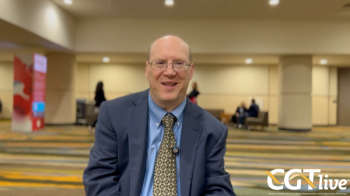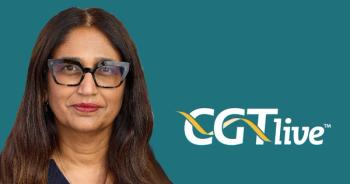
Phase 3 Trial Seeks to Continue Supporting Arsa-Cel Gene Therapy for MLD
The gene-edited cell therapy has been approved as Lenmeldy by the FDA.
The FDA
The FDA’s decision was based on data from patients treated with arsa-cel across 2 clinical trials (NCT01560182; NCT03392987) and additional patients treated in expanded access frameworks. These patients had follow-up times ranging from 0.64 years to 12.19 years (median, 6.76).3
“Metachromatic leukodystrophy, is a really important unmet need in the pediatric community. So, this is a disease that's rare, it affects about one in 40,000 children. And up until recently, we have had no curative treatment option for this,” Madeleine Powys, MBBS, Staff Specialist, Blood Transplant and Cell Therapies, The Children's Hospital at Westmead, told CGTLive. "Autologous hematopoietic stem cell gene therapy has offered really promising new hope for these patients.”
WATCH NOW:
Arsa-cel is currently being evaluated in 6 participants enrolled in a phase 3 clinical trial (NCT04283227). The trial enrolled participants with documented biochemical and molecular diagnosis of MLD, including low ARSA activity and identification of 2 disease-causing ARSA alleles, with novel mutations analyzed and excluded as common polymorphisms, alongside specific genotype criteria. Symptomatic individuals must have onset between 7 and 17 years of age, or pre-symptomatic participants must be less than 17 years at treatment initiation and have a sibling with late-juvenile MLD variant, along with normal cognitive and motor function, with seizures or disease signs revealed by instrumental evaluations not being exclusionary if present alone, and compliance with contraceptive use requirements if applicable, with signed informed consent or assent provided by the participant or guardian.
The exclusion criteria for the study include documented HIV infection, malignant neoplasia except localized skin cancer or hereditary cancer syndrome unless successfully treated with no recurrence, myelodysplasia, acute myeloid leukemia, or serious hematological disorders, current enrollment in other interventional trials, prior allogeneic HSPC gene therapy or gene therapy, symptomatic herpes zoster unresponsive to treatment, active tuberculosis unless on antibiotic prophylaxis, acute or chronic stable Hepatitis B or positive Hepatitis C RNA test result unless specific conditions are met, end-organ dysfunction, severe infection not responsive to treatment, or other severe diseases deemed inappropriate for the study by the investigator. Additionally, testing for other transmissible infectious agents may be considered, and participants with elevated liver enzymes or bilirubin may be included after discussion and agreement with the medical monitor.
The study’s primary measures involve assessing the OTpbmsL-200 Arylsulfatase A (ARSA) activity levels in cerebrospinal fluid (CSF) and the neuronal metabolite ratio of N-acetyl-aspartate (NAA) to creatine (Cr) in white matter brain regions, both evaluated at 24 months post-treatment, with changes from baseline being monitored.
Secondary measures involve evaluating changes in ARSA activity levels in CSF and neuronal metabolite ratio in white matter brain regions, assessing ARSA levels in peripheral blood mononuclear cells (PBMCs) and specific subtypes, comparing neuronal metabolite ratios to baseline, siblings, or untreated controls, determining engraftment through lentiviral positivity in bone marrow progenitors and vector copy number in BM cells and PBMCs, assessing severity scale for brain MRI, neurocognitive function, full neurological clinical examination, gross motor function classification, nerve conduction velocity, Vineland Adaptive Behavior Scale, and monitoring conditioning regimen and non-conditioning-related adverse events up to 8 years post gene therapy, along with hematological reconstitution, infusion-related reactions, immune response, abnormal clonal proliferation, replication-competent lentivirus, and integration site analysis findings over time.
The
"This represents of course, the proof of principle that gene therapy with ex- vivo lentiviral gene therapy into stem cells can correct a lysosomal storage disorder (LSD)... and could be applicable to other LSDS. So we're working on new diseases to bring this approach of enzyme correction also to other LSDs," investigator Alessandro Aiuti, MD, PhD, deputy director, clinical research, and head, Clinical Research Unit, San Raffaele Telethon Institute for gene therapy, and Group leader, Pathogenesis and therapy, primary immunodeficiencies unit, and full professor, Università Vita Salute San Raffaele, and chief of clinic, Pediatric Immunohematology Unit, San Raffaele, told CGTLive.
Data from these participants showed that they all had normal hematological reconstitution and engraftment that was consistent with arsa-cel outcomes seen in patients with early-onset MLD who have been treated in other settings. Time to neutrophil engraftment ranged from 26 to 42 days (median, 33) posttreatment and time to platelet engraftment ranged from 25 to 46 days (median, 26) posttreatment. ARSA activity reached supranormal levels in the PBMCs and in CD15+ cells and increased to normal levels in the CSF in 3 patients for whom central nervous system pharmacodynamic efficacy measures were available.At 90 days after administration of arsa-cel transduced bone marrow progenitors made up between 23.81% to 81.25% of bone marrow progenitors. At this time point, the PBMCs showed a median vector copy number (VCN) of 0.49 copies/cell and the CD15+ cells showed a median VCN of 0.82 copies/cell.4
In terms of safety, there were no serious adverse events (SAEs) deemed potentially related to arsa-cel. One nonserious AE deemed potentially related to the therapy, a case of erythematous rash, occurred in 1 patient. No SAEs deemed potentially related to the Busulfan conditioning regimen occurred; although cases of febrile neutropenia, cytopenia, and stomatitis were deemed to have potential relation to the regimen. An SAE of upper respiratory tract infection occurred in 1 patient. One patient with prolonged thrombocytopenia who had previously experienced treatment-failure with allogeneic transplant in the form of autologous reconstitution was administered thrombopoietin receptor agonist therapy for 5 months. No multilineage engraftment of transduced cells or malignancy occurred and there was no indication of clonal expansion or replication competent lentivirus.4
REFERENCES
1. FDA Approves First Gene Therapy for Children with Metachromatic Leukodystrophy. News release. Orchard Therapeutics. March 18, 2024. Accessed March 18, 2024. https://www.fda.gov/news-events/press-announcements/fda-approves-first-gene-therapy-children-metachromatic-leukodystroph
2. Orchard Therapeutics announces acceptance of biologics license application for OTL-200 in MLD and receives priority review. News release. Orchard Therapeutics. September 18, 2023. Accessed September 18, 2023. https://ir.orchard-tx.com/news-releases/news-release-details/orchard-therapeutics-announces-acceptance-biologics-license
3. Fumagalli F, Calbi V, De Mattia F, et al. Long-term clinical outcomes of atidarsageneautotemcel (autologous hematopoietic stem cell gene therapy) preserves cognitive and motor development in early-onset metachromatic leukodystrophy with up to 12 years follow-up. Presented at: WORLDSymposium, held February 4-9, in San Diego, California. Poster #92
4. Gallo V, Calbi V, De Mattia F, et al. Lentiviral hematopoietic stem cell gene therapy (atidarsageneautotemcel) for late juvenile metachromatic leukodystrophy (MLD). Presented at: WORLDSymposium, held February 4-9, in San Diego, California. Poster #96
Newsletter
Stay at the forefront of cutting-edge science with CGT—your direct line to expert insights, breakthrough data, and real-time coverage of the latest advancements in cell and gene therapy.











































